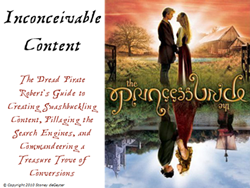In my last post, I talked about training your text to “engage”, “inform”, “speak” (call to action), and “convert”. The first step is to make sure the content doesn’t overstay it’s welcome. In this post, I’ll provide some of the tricks you can teach your content; training it how to do all of these things by making it skim-able, scan-able and provide exits to where the visitor needs to go next.
Teaching tricks the audience likes
 There are two kinds of tricks you can train your text to do: the kind of tricks you like or the kind of tricks your audience likes. Obviously, training your text to do the tricks you like will make you happy… but it won’t make your audience happy. You think the tricks are cool, but nobody else does. And… that’s just not cool.
There are two kinds of tricks you can train your text to do: the kind of tricks you like or the kind of tricks your audience likes. Obviously, training your text to do the tricks you like will make you happy… but it won’t make your audience happy. You think the tricks are cool, but nobody else does. And… that’s just not cool.
Most people who visit websites scan them first, then skim the text. But, they only skim read if they get intrigued by their initial scan, and they read it only if they find something compelling and interesting that warrants their full attention. There are four easy ways to train your text to be scan-able:
Paragraph headings: Your page should have a proper heading and your content should be broken up with paragraph headings throughout, depending on length. Don’t get carried away by placing a heading before each paragraph. That overkill. But the longer your text is, the more it needs to be broken up into easily digest chunks that allow your readers to consume it.
Internal linking: One of the biggest missed opportunities on business websites is linking their content to other relevant areas of the site. That’s what the navigation is for, right? Yes and no.
Your navigation needs to do a proper job of allowing people to find what they are looking for, but relying on it too heavily forces the visitor to know what they are interested in finding. But, adding links into your content streamlines both of those issues and also helps the visitor get to where they want to go much quicker. This is more intuitive and requires little thought or effort on their part.
 Bolded Text: Bolding key words, phrases, and sentences can also allow your visitors to find key points as they quickly scan your content. Note that I said “key words”, not “keywords”. There is nothing wrong with using keywords in your bolded text, but that should not be the reason for using bold text. You bold text because it’s important, not because you want to get a keyword in bold font.
Bolded Text: Bolding key words, phrases, and sentences can also allow your visitors to find key points as they quickly scan your content. Note that I said “key words”, not “keywords”. There is nothing wrong with using keywords in your bolded text, but that should not be the reason for using bold text. You bold text because it’s important, not because you want to get a keyword in bold font.
Bullet Points: Bullet points are another way to get your visitors to read key information without having to read every word of content. Most readers will read bulleted lists while ignoring everything else on the page.
Bullets provide a very easy way to read quick bits of information that otherwise might get lost in a single paragraph. Bullet points also break up your content, which also makes the text more scan-able and skim-able. You can also use bullet points to link to other areas of your site that provide additional information without mucking up the current page content.
Or, to put it another way, bullet points:
- Provide quick bits of information
- Break up content to be more scannable and skimmable
- Provide linking opportunities to related content
People love tricks. But, they don’t like to be tricked. These tricks that you can use to train your content are not and should not be used as a means to deceive your audience. They are tricks that help you communicate with your audience in a way that is more to their liking. Giving people what they want isn’t deceptive, unless you are pulling the rug out from under them later.
You can train your content to do things that other sites are not doing. By teaching it to keep your audience engaged with the site, and training it how to direct your readers to other areas of the site they are interested in, you’re just helping people find what they need. If they don’t find it with you, they will with someone else… likely because their content has learned these tricks.
 This post was inspired from The Princess Bride themed presentation I gave in early 2010 at SEMpdx’s Searchfest titled Inconceivable Content: The Dread Pirate Robert’s Guide to Creating Swashbuckling Content, Pillaging the Search Engines, and Commandeering a Treasure Trove of Conversions. If you enjoyed this post you also might enjoy other posts inspired from the same. Search for “inconceivable content” on this blog to find them all.
This post was inspired from The Princess Bride themed presentation I gave in early 2010 at SEMpdx’s Searchfest titled Inconceivable Content: The Dread Pirate Robert’s Guide to Creating Swashbuckling Content, Pillaging the Search Engines, and Commandeering a Treasure Trove of Conversions. If you enjoyed this post you also might enjoy other posts inspired from the same. Search for “inconceivable content” on this blog to find them all.
